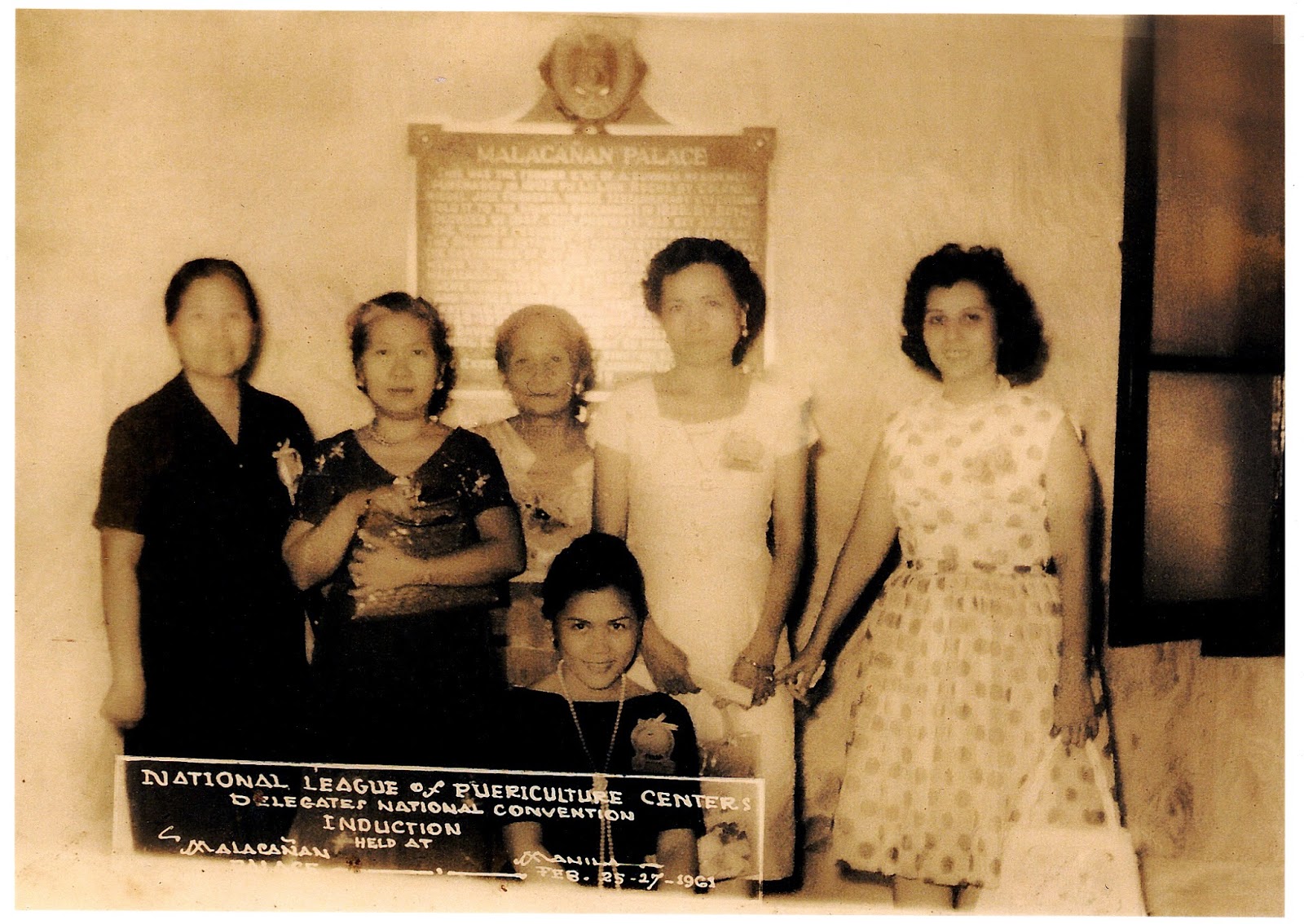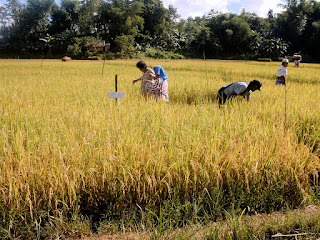The Center of Balete
Center. That is the way Baleten-ons referred
to the Municipal Health Office since my childhood days. And it stuck until to
now. I am particular to this reality as the family used to reside behind the
old Puericulture Center of Balete where both my father and mother worked. When
my mother got hired as Rural Health Midwife for Balete Rural Health Unit, the
family decided to relocate and bought a small house behind it. It was easy to
recognize one another then as there were only a handful of households in the poblacion. It was simply either one is
from Ilaya or Ilawod.
The "Center" is geographically
situated at the heart of the poblacion
along with the old Town Hall, the Band Stand and the Church. It served as the
boundary for the "taga-ilaya"
and "taga-ilawod". It was
implicitly regarded as a neutral place where animosity is temporarily set
aside among the "warring gangs" of Ilaya and Ilawod. As
the bell tolled to call the community to Angelus, any contest by the rival
gangs were to be set aside, at least for a while. At nighttime, its spacious
covered patio was a rendezvous for the Romeos and Juliets of the Poblacion.
The "Center" is known by many
names. Originally, it was the Puericulture Center of Balete when it was first
established in 1957. A cholera outbreak struck the community in the early 50's
and the government relied on the humanitarian interventions of the National
Federation of Women's Club of the Philippines (NFWCP) as there was no health
personnel assigned in Balete at that time. While it is true that as early
as 1921, the Public Welfare Commission was already tasked of supervising and
organizing puericulture centers in the countryside with a mandate that all
centers should have a doctor, a nurse, a midwife and a social worker, all to be
paid by the government, the lack of funds delayed its establishment in
Balete. It took the persistence of the strong-willed Pacita Calizo-Cortes,
the chapter president of NFWCP, to bring in funds that pave for the eventual
establishment of the "Center" and later on, its satellites in Aranas
and Calizo.
In 1961, the World Health Organization,
the United Nations Children's Fund, the Philippine Charity Sweepstakes Office
and provincial governors funded the construction of puericulture center
buildings across the country. Remnants of the PCSO-funded centers are still
standing up to now in Barangay Aranas and Barangay Calizo although the lack of
appropriate documents--Deed of Donations--prevented the local government from
undertaking their rehabilitation. But with the dearth of health personnel where
there was only one midwife who rounded the barrios as the doctor and the nurse
were "center-based", the people relied so much on the active
involvement of the NFWCP for their health and sanitation needs and in their
absence, from the community cirujanos
(not to be confused with the cirujanos
ministrates—male nurses—of the Spanish era) and herbolarios (or albularyo).
Thus, that generation remembers its one and only president as the Florence
Nightingale of Balete for her advocacy in promoting health and sanitation among
the rural folks. Her death in 1963 therefore was regarded as a great lost that
eventually led to the fading out of her Women's Club even before the onset of
the Marcos years.
During the Martial Law years, the
"Center" became known as Rural Health Unit where it welcomed batches
of newly graduated health practitioners doing their mandatory Rural Health
Service. Nurses and midwives reached out into the barrios to provide the needed
health services to complement (or counteract—whatever) the Community-Based
Health Practitioners' efforts at reaching out to the rural masses.
The passage of the Local Government Code
in 1991 dramatically brought changes which devolved health services and its
personnel administration under the local government units (LGUs). The
"Center" took form to be called thus as the Municipal Health Office
with the Municipal Health Officer as its Department Head. As if wanting to
radically change everything in it, a powerful earthquake pulverized the
building in June of that year. But the spirit of Pacita held on. Through the
appeal of her daughter, Ma. Cecilia Cortes-Vergara, who was the confidential secretary then of
Secretary Raul Manglapus at the Department of Foreign Affairs, then Department
of Health Secretary Alfredo Benzon appropriated certain amount for the
immediate construction of a new health center.
With the new "Center" rising out
from the rubles of the old and beloved puericulture center, the local officials
were said to have committed to rename it in honor of the memory of Pacita
Calizo-Cortes and a way of saying thank-you to Ms. Vergara. In as much as it
was now under the LGU, the Sangguniang Bayan by virtue of the LGC can and has
the power to rename it upon consultation with the National Historical Institute
(now National Historical Commission of the Philippines). Eventually, a signage
bearing the name "Pacita Calizo-Cortes Memorial Health Center" was
installed prominently atop the new "Center" (people keep on calling
it that way even if it the old structure is no more and the new one has a
different feature and name).
A recent (June 26, 2014) milestone
ordinance enacted by the Sangguniang Bayan of the Municipality of Balete is a
ratification of the use of name "Pacita Calizo-Cortes Health Center"
as the official name of the Municipal Health Office. It is a belated
legislative intervention to rectify the inadvertence of the past. The people of
Balete have noted the signage for the past 23 years but no one bothered to
inform the public who Pacita Calizo-Cortes was and why was a public, a health
edifice for that matter, has to be named after her. She was not even a
government official nor held a government position during her time.
So you ask me who is Pacita Calizo-Cortes
and why the “Center” is officially named in her memory. The Sangguniang Bayan
provides us the clue. Allow me then to quote in toto its brief introduction to Ordinance No. 35, s. 2014:
“The late Pacita Calizo-Cortes is beloved by the people of Balete in her time for her dedication and commitment in promoting health programs especially for the poorest of the poor. She was said to have selflessly reached out to barriofolks of Balete who were maligned by cholera outbreak in the 50’s. She worked hard for the eventual establishment of the Puericulture Center, the precursor of the Rural Health Unit which was the reason why up to now, people call it with affection as the “Center.” She served as its president since its establishment until her death in January 5, 1963. The younger generation however needs to be reminded of her legacy while at the same time we deemed it proper to preserve her memory as a relevant chapter in the history of our town.
“Pacita F. Calizo – Cortes was the youngest daughter of Adriano C. Calizo, former Gobernadorcillo of Balete way back in 1882, to Doña Petra Feliciano-Calizo. Her contemporary referred to her as the Florence Nightingale of Balete. Her elder brother was Miguel F. Calizo, Presidente Municipal (Municipal Mayor) of Balete during the American period in 1923-1925; during the Japanese occupation in 1941-1945; and from 1946-1947 when the Philippines was savoring its newly gained independence.
“The Rural Health Unit of Balete has carried the name “Pacita Calizo-Cortes Memorial Health Center” for many years now. While national government agencies, particularly DOH and Philhealth recognized it as the Balete Rural Health Center, the people of Balete are well aware of the name of that venerable lady as the one imposed on its signage.
“It is for these reasons then that the Local Health Board of the Municipality of Balete, heeding the request of the Heirs of the late Pacita Calizo-Cortes, recommended the ratification of the use of her name as the official name of the Rural Health Unit of Balete, Aklan. For aesthetic consideration per the recommendation of the National Historical Commission of the Philippines, the word “memorial” shall be omitted thus.”
The Sanggunian
Bayan acted on the matter based upon a resolution unanimously adopted by the
Municipal Health Board of Balete on May 8, 2014. The resolution was favorably
endorsing the letter of the Heirs of the late Pacita Calizo-Cortes who were
seeking its intervention to affirm with legislative mandate the use of the name
of their mother as the official name of the center.
The poblacion
has dramatically changed over the years and with it comes new orientations, new
values, new priorities for a diversified community. The “Taga-ilawod” and the Taga-ilaya” are still there adapting and
adjusting to the changes that came with the “sprouting” of new communities in
growing urbanization of Balete. The rivalry is no longer as intense as before,
and yet, the Center remains their spontaneously agreed boundary.




Hello! I am Errol Ordines, a registered nurse and an advocate of Aklan's rich heritage and culture. I am one of the contributors of a facebook page named "Ro Akeanon" (https://www.facebook.com/TheAkeanon), which aims to advocate to the young generations the importance of our culture and heritage. Your blogspot is really educational as it tackles different part of our history as Akeanons. Can I possibly share your pictures and trivia in the said page? We will credit your blogspot as the source of the photos and infos. Thanks and God bless!
ReplyDeleteHello Errol! Go ahead. We are on the same boat rowing the rivers of Aklan. God bless your advocacy!
ReplyDelete